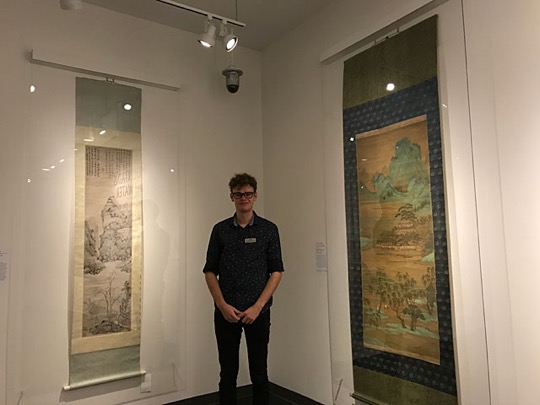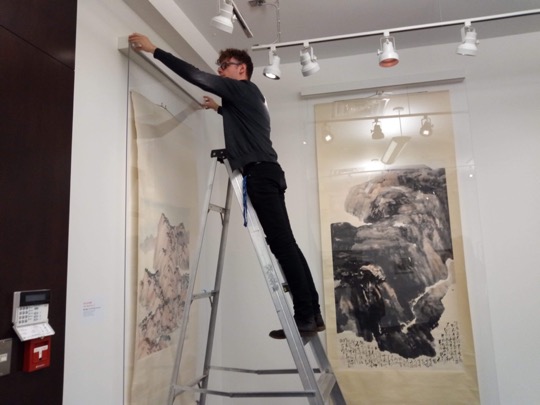UAM Summer Internship 2018: Exhibition Preparation
Martin Bierens - 30 August 2018
It has been a few weeks since I have had the time to sit down and write another blog post. Since my last post, the pace here at the University of Alberta Museums has picked up immensely. Recently, we have opened up a new exhibition, Mountains and Water: Visions of the Land in Canada and China, featuring works of art from the Mactaggart Art Collection and the University of Alberta Art Collection.
Mountains and Water is an exhibition that celebrates the opening of the Jonathan KS Choi Cultural Centre of Canada in partnership with the China Institute. For this exhibition, I mostly helped with the installation of Chinese art from the Mactaggart Art Collection, which mostly consists of hanging scrolls, along with some banderols and albums. The hanging scrolls certainly provided the biggest challenge due to the nature of the art form. Hanging scrolls, as the name suggests, hang. Most of these scrolls are quite large, with many being nearly floor to ceiling in length. The longest of which was done by Wang Shimin in 1657, and is 107 inches long or 8.9 feet!

But, it is not actually the size of the hanging scrolls that provide the largest challenge for installation, but the physical nature of the scrolls themselves. hanging scrolls are mounted on thin silk, so they are very fragile. This means that they have to be covered with sheets of Plexiglass in order to protect the scrolls. This is to prevent visitors to the exhibit from touching the scrolls and they are viewing them, or from accidentally brushing against them.
Though the Plexi does provide lots of protection to the hanging scrolls behind them, there are several cons to using Plexi as a barrier. Despite the name, it's not a typical kind of glass. Rather, the technical term is acrylic glass which means that a large portion is actually plastic compounds This produces some issues, the biggest being the tendency to scratch, due to the plastic-like qualities it exhibits. A badly placed scratch has the potential to greatly take away from the visitor experience. If I were to go to a museum, view a display and there was a scratch on the Plexiglass right in the middle of the object I was regarding, it would certainly draw my attention away from the item and towards the scratch. That is not what a visitor wants to be focusing on when they are attempting to view the display. This simply requires those installing the exhibition to be careful when handling the Plexi. Luckily, our installation went smoothly and we did not incur any damage!

Plexi does have its drawbacks, but compared to regular glass there are many pros. Plexi is incredibly resilient. It may be easy to scratch, or lightly damage but it is nearly impossible to completely shatter a sheet. It is the material that they use to surround hockey rinks, so if it is able to withstand a frozen puck that is moving at ninety miles per hour, it should be able to protect against an eager museum visitor who may accidentally poke it with their finger. Regular glass in contrast may be more scratch-resistant, but there is the unpredictability of a scratch completely shattering the entire sheet. This would likely cause more damage to anything that it was originally intended to protect, which defeats the purpose of a protective covering in the first place.
Come check out some of these gorgeous hanging plexiglass sheets, as well as the art that they are protecting in Gallery A of the TELUS Centre. The exhibit features work from Chinese masters, such as Wen Zhengming and Qui Ying, as well as prominent Canadian artists, like Group of Seven members A.J. Casson and A.Y. Jackson. The exhibition is running from now until October 6, 2018. Hours are Thursday-Friday 12pm-5pm and Saturdays from 2pm-5pm. Find more information at the University of Alberta Museums website.